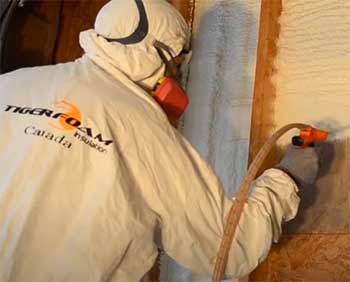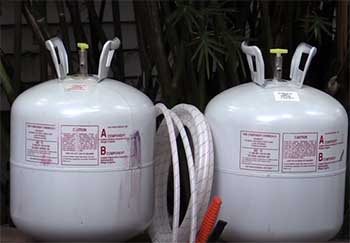When it comes to home insulation, one product that consistently catches attention is Tiger Foam. If you’re in the market for an effective, user-friendly insulation solution, this might just be what you need.
But before you make a decision, let’s unpack my experience and what others are saying about Tiger Foam insulation. Spoiler alert: It’s worth considering for your next insulation project!
Why Should You Consider Buying Tiger Foam Insulation?
From my experience and extensive research, Tiger Foam stands out due to its ease of use, impressive insulation properties, and safety features.
Whether you’re looking to insulate a small area or an entire room, this product provides a reliable solution.
The convenience of having a disposable and recyclable tank, coupled with a self-contained delivery system, makes it particularly appealing for DIY enthusiasts and professionals alike.
My Experience Applying Tiger Foam Insulation

Preparation
Before diving into the actual application, preparation is crucial. I started by making sure the area I was going to insulate was clean and dry. I also made sure the product, and the room, was at least 75°F. This ensures that the foam adheres properly and cures correctly.
Equipment and Safety
Safety is paramount when dealing with spray foam insulation. I wore a Tyvek suit, gloves, goggles, and a respirator to protect myself from the fumes and the sticky foam. It’s essential to have good ventilation in the area you are working in to minimize exposure to fumes.
Step-by-Step Guide to Applying Tiger Foam Insulation

- Read the Instructions: Start by thoroughly reading the instructions that come with the kit. This will give you a good understanding of how the product works and the safety measures you need to take.
- Set Up the Equipment: Attach the 9.5 ft hose and gun to the tanks. Make sure all connections are tight to prevent leaks. The kit comes with various nozzle tips – choose the one that suits your application needs.
- Prepare the Area: Clear the area of any obstacles and cover any surfaces you don’t want the foam to get on. I used plastic sheets to cover the floor and any nearby furniture.
- Shake the Tanks: Shake the tanks vigorously for a couple of minutes to ensure the chemicals are well-mixed. This is a crucial step for achieving a consistent spray.
- Test Spray: Before applying the foam to the actual surface, do a test spray on a piece of cardboard or a small section of the wall. This helps you get a feel for the spray pattern and adjust the gun if necessary.
- Apply the Foam: Hold the gun about 18-24 inches away from the surface and apply the foam in a steady, sweeping motion. Avoid stopping and starting frequently, as this can cause uneven application. It’s best to apply the foam in layers, allowing each layer to cure before applying the next one.
- Change Nozzles Regularly: The kit includes multiple nozzles for a reason. Change the nozzle every few minutes to prevent clogs and ensure a consistent mix of the two components.
- Allow to Cure: After application, allow the foam to cure for at least 24 hours. This ensures it fully expands and hardens to provide the best insulation.
- Clean Up: Dispose of the used nozzles and any leftover material according to local regulations. The tanks are disposable and recyclable, making cleanup straightforward.
Results
The results were impressive. The foam expanded as expected, providing a solid layer of insulation that significantly improved the temperature control in the room. There were no issues with the mix, and the foam adhered well to the surfaces. The room felt noticeably warmer, and I expect to see a reduction in my energy bills over time.
Pros of Tiger Foam Insulation
- High R-Value
One of the standout features of Tiger Foam is its high R-value. With an R6 per inch, it offers superior insulation, ensuring that your home remains energy efficient.
- Easy Application
The product is designed for ease of use. Even if you’ve never used spray foam insulation before, the instructions are straightforward, and the kit includes everything you need to get started. I found the application process smooth and hassle-free.
- Safety Features
Tiger Foam is ASTM E-84 fire-rated, which means it meets stringent safety standards. This is a significant plus if you’re concerned about fire hazards.
- Complete Kit
The inclusion of various nozzle tips and a 9.5 ft gun and hose makes the application process flexible. Whether you’re dealing with tight corners or large surfaces, you have the tools you need.
- Energy Efficiency
By providing a high R-value, Tiger Foam helps in maintaining indoor temperatures, reducing the need for heating and cooling, and ultimately saving on energy bills.
Cons of Tiger Foam Insulation
- Cost
One of the main drawbacks is the cost. Tiger Foam is not the cheapest option on the market. However, considering the benefits and performance, many users find it worth the investment.
- Potential for Waste
Some users have reported issues with the proportioning of the two parts, leading to leftover material and increased cost. Ensuring that parts A and B mix correctly is crucial to avoid this problem.
Maintenance Tips for Tiger Foam Insulation
- Proper Storage

To maximize the shelf life of Tiger Foam, store it in a cool, dry place.
Avoid exposing the product to extreme temperatures, which can affect its performance.
- Nozzle Maintenance
Regularly changing the nozzles during application is key to preventing clogs and ensuring a consistent spray.
The kit provides extra nozzles, so don’t hesitate to switch them out as needed.
- Safety Precautions
Always wear protective gear, including gloves, a respirator, and protective clothing, when applying the foam. Ensure the area is well-ventilated to minimize exposure to fumes.
- Disposal
The tanks are disposable and recyclable, making cleanup easy. Follow local regulations for disposing of the tanks and any leftover material.
Comparison With Other Brands
When comparing Tiger Foam with other insulation brands, several factors come into play, such as cost, ease of use, and insulation properties.
Great Stuff Pro
Pros:
- More affordable.
- Easy to find in local hardware stores.
- Good for small projects.
Cons:
- Lower R-value compared to Tiger Foam.
- Can be messier to apply.
Dow Froth Pak
Pros:
- High R-value similar to Tiger Foam.
- Comes with detailed instructions and support.
Cons:
- More expensive.
- Larger setup required, not as portable.
Foam It Green
Pros:
- Comes with a color indicator to ensure proper mixing.
- Good customer support and resources.
Cons:
- Higher cost.
- Slightly lower R-value per inch.
Frequently Asked Questions (FAQ)
Expanding foam can be tricky to apply correctly, and if not done right, it can lead to waste or uneven surfaces. Additionally, it can be messy, and the fumes require proper ventilation and safety precautions.
Closed-cell foam insulation, like Tiger Foam, is generally considered the best due to its high R-value and moisture resistance. It provides superior insulation and structural support compared to open-cell foam.
The main downsides include the cost and the need for proper application techniques. Spray foam insulation can be expensive, and if not applied correctly, it can lead to issues with air sealing and waste.
Yes, Tiger Foam is ASTM E-84 fire-rated, making it a safe option for home insulation. However, it’s important to follow all safety guidelines during application, including wearing protective gear and ensuring proper ventilation.
Wrapping Up
After using Tiger Foam and comparing it with other products, I can confidently say it’s a solid choice for anyone needing reliable and effective insulation. The ease of use, high R-value, and safety features make it a standout product.
Yes, it comes with a higher price tag, but the benefits and energy savings over time justify the cost.
In the end, if you’re looking for an insulation solution that combines performance, safety, and convenience, Tiger Foam is worth the investment. It’s an excellent option for both DIY projects and professional use, ensuring your space remains comfortable and energy-efficient.
In summary, Tiger Foam insulation offers a robust solution for anyone looking to improve their home’s energy efficiency and safety. Despite a few drawbacks, its benefits far outweigh them, making it a worthwhile investment for your insulation needs.

